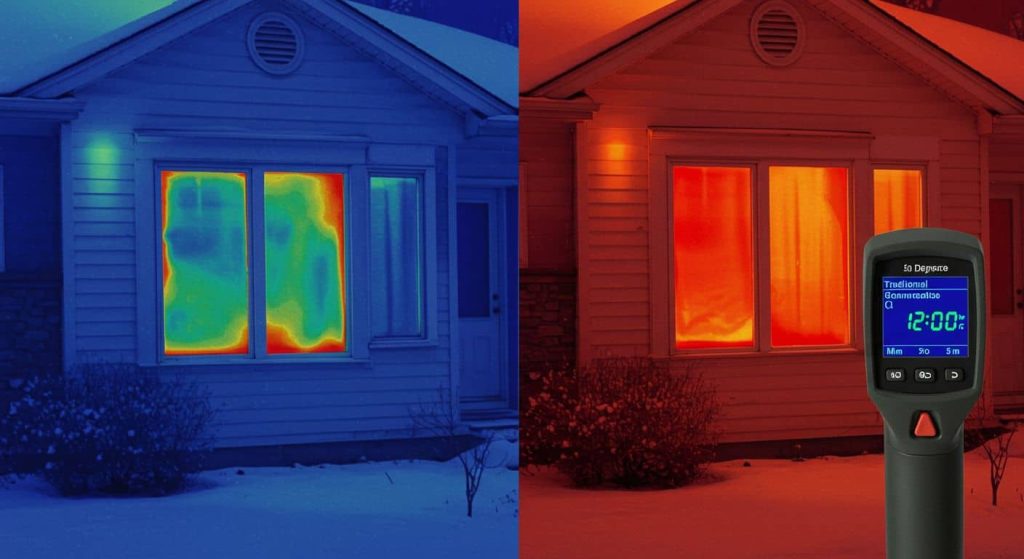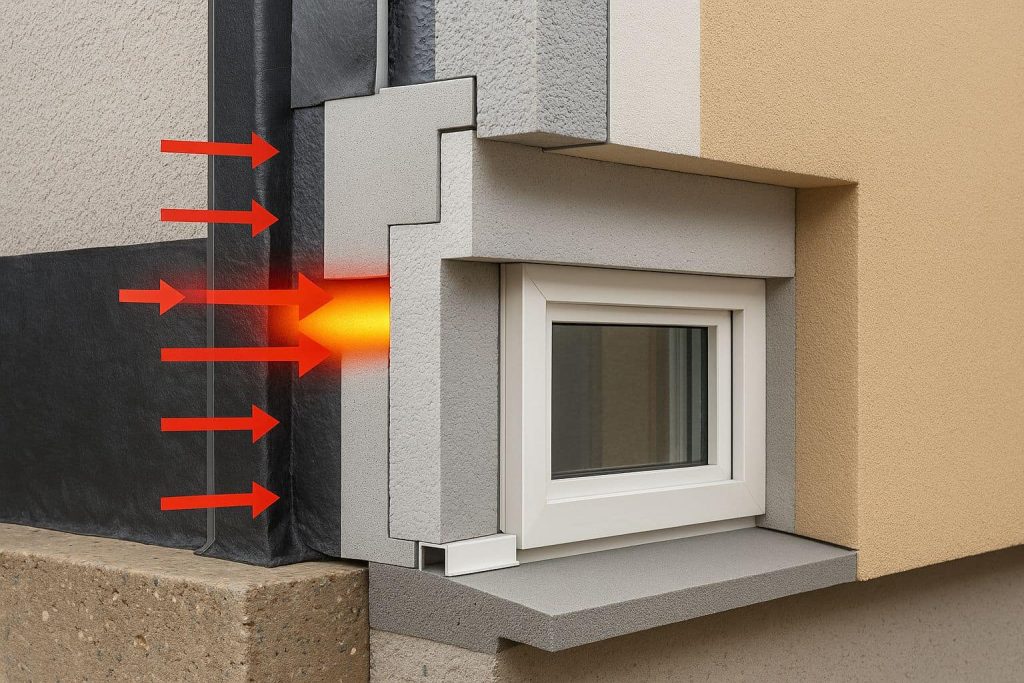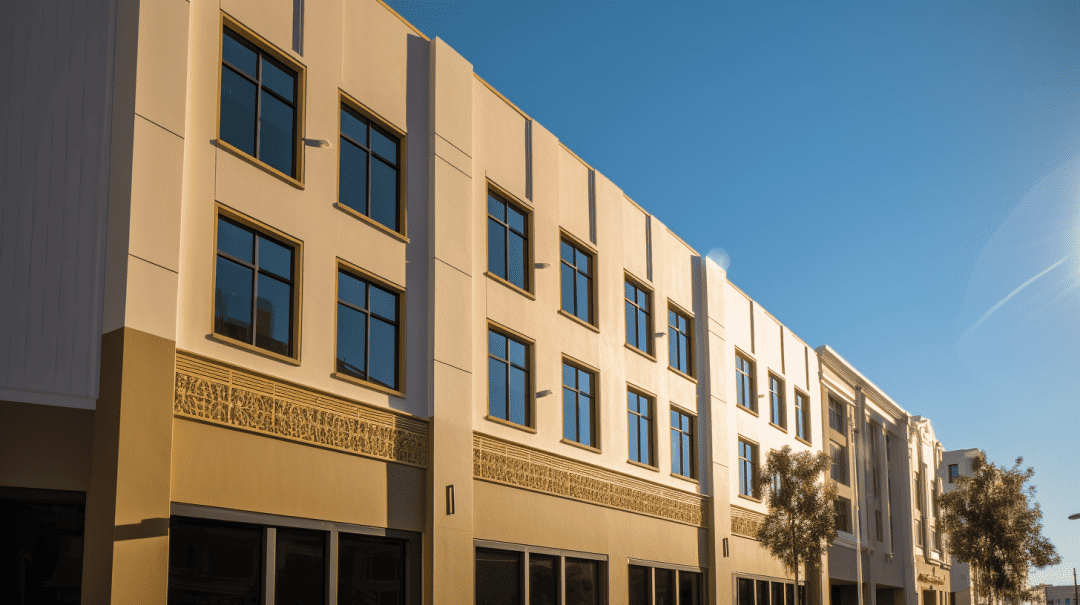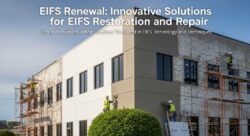Preventing Heat Loss Starts With Proper Window Return Details
When it comes to energy efficiency and building performance, the devil is in the details. And nowhere is this more true than in window return details for Exterior Insulation and Finish System (EIFS) installations.
After 22 years in the EIFS business and working on everything from massive commercial projects to detailed residential repairs across Indiana, I’ve seen firsthand how thermal bridging can turn what should be an energy-efficient wall system into a thermal disaster.
Here’s the bottom line: thermal bridges around windows are one of the biggest energy wasters in modern construction. But with the right techniques and attention to detail, EIFS can help eliminate these problems entirely.

Key Takeaways
- Thermal bridging at window returns can reduce overall wall thermal performance by 15-25%
- Proper continuous insulation techniques can eliminate cold bridge effects entirely
- Window buck alignment and backwrapping techniques are critical for thermal success
- Climate zone 5 requirements demand specific attention to dew point control
- Professional installation prevents costly condensation risk and energy loss
Understanding Thermal Bridging in EIFS Systems

Let’s start with the basics. Thermal bridging happens when heat finds an easy path through your building envelope. Think of it like water finding the lowest point – heat flow will always take the path of least resistance.
Energy Loss Through Thermal Bridging
Traditional Construction
Heat Loss at Windows
Proper EIFS Installation
Heat Loss at Windows
Continuous insulation eliminates up to 22% of window-related heat loss
In traditional construction, windows create massive thermal bridges. The metal or wood frame conducts heat right through the wall, bypassing all that expensive insulation you paid for. It’s like leaving a door open in winter – your heating and cooling system works overtime to compensate.
EIFS offers a unique advantage here. When properly installed, an EIFS system creates a continuous insulation layer that can wrap around window openings, eliminating these thermal shortcuts entirely. Our comprehensive EIFS installation guide for first-time homebuilders covers these fundamental principles in detail.
The Science Behind Heat Transfer
Building science tells us that heat moves in three ways: conduction, convection, and radiation. Thermal bridges primarily deal with conduction – direct heat transfer through materials.
In climate zone 5 (where most of Indiana sits), we face significant temperature swings. Winter temperatures can drop well below freezing, while summer heat pushes cooling systems to their limits. Every thermal bridge represents wasted energy and uncomfortable indoor conditions.
EIFS helps by creating that crucial thermal barrier. The continuous insulation system means there are no gaps for heat to sneak through. But only if it’s installed correctly.
Window Return Details: The Critical Connection
Here’s where things get technical, but stick with me – this stuff matters for your energy bills.
Window return detail refers to how the EIFS wall assembly connects to the window frame. Get this wrong, and you’ve created a thermal highway for heat loss. Get it right, and you’ve got a high thermal performance wall that will reduce energy consumption for decades.
Traditional Problems We Solve
Most contractors treat window installations like an afterthought. They’ll frame the opening, install the window, and then try to figure out how to make the exterior cladding work around it. This backwards approach almost always creates thermal bridging effects.
Common mistakes include:
- Installing windows flush with the structural frame
- Failing to plan for continuous insulation
- Using thermal buck details that create cold spots
- Inadequate window jamb insulation and sill insulation
- Poor air barrier continuity
Professional Installation Techniques
At Indiana Wall Systems, we’ve developed specific techniques that minimize thermal bridging while ensuring long-term durability. Here’s how we approach window return details:
Step 1: Substrate Preparation and Planning
Substrate preparation starts before the window ever arrives on site. We work with builders to ensure window buck alignment accommodates the full EIFS wall thickness, including:
- EPS foam board or graphite enhanced EPS insulation
- Base coat thickness and lamina reinforcement mesh
- Finish coat texture requirements
- Proper drainage and flashing membrane integration
Step 2: Thermal Buck Installation
A thermal buck is essentially a frame that extends the window opening outward to accommodate the full wall assembly. This is where many contractors cut corners, but it’s absolutely critical for cold bridge elimination.
We use engineered thermal bucks that:
- Extend the full depth of the EIFS system
- Provide airtight window bucks when properly sealed
- Allow for continuous gasket installation
- Maintain air barrier continuity
Step 3: Insulation Continuity
This is where the magic happens. Using continuous insulation around the window opening eliminates the direct conductive path that creates thermal bridges.
Our backwrapping technique involves:
- Cutting EPS foam board to wrap around the thermal buck
- Ensuring no gaps in the continuous insulation layer
- Proper adhesive attachment and mechanical fasteners as needed
- Window perimeter sealing with appropriate materials
Professional EIFS Window Installation Process
Substrate Prep
Window buck alignment & thermal planning
Thermal Buck
Extended frame installation for continuous insulation
Backwrapping
EPS foam around opening with no gaps
Air Barrier
Continuous sealing & drainage integration
Step 4: Air Barrier and Drainage Integration
Air barrier continuity is just as important as insulation continuity. We use flexible flashing tape and specialized sealants to create a continuous seal between the window frame and the EIFS wall assembly.
The drainage plane must also be properly integrated. Our water-resistive barrier (WRB integration) ensures that any moisture that does penetrate the system can drain away without causing problems.
Material Selection for Optimal Performance
Not all insulation materials are created equal when it comes to thermal performance. Here’s what we typically specify:
Insulation Options
EPS foam board remains our go-to choice for most applications. It provides excellent thermal resistance at a reasonable cost. For higher-performance applications, graphite enhanced EPS offers improved R-value in the same thickness.
Extruded polystyrene has higher compressive strength but comes at a cost premium. We reserve it for areas with specific structural requirements.
Closed-cell spray foam can be used for complex geometries where rigid boards won’t work, but it requires careful attention to vapor permeability and compatibility with EIFS construction.
Performance Metrics
When evaluating materials, we look at:
- Linear thermal transmittance (psi-value calculation)
- R-value and overall thermal efficiency
- Vapor permeability characteristics
- Compatibility with EIFS industry standards
- Long-term durability and service life extension
EIFS Insulation Material Performance
| Material Type | R-Value per inch | Thermal Performance | Cost Grade |
|---|---|---|---|
| Standard EPS Foam | R-4.0 | GOOD | $ |
| Graphite Enhanced EPS | R-4.7 | BETTER | $$ |
| Extruded Polystyrene | R-5.0 | BEST | $$$ |
| Closed-Cell Spray Foam | R-6.5 | PREMIUM | $$$$ |
Quality Control and Testing
Professional installation isn’t just about following procedures – it’s about verifying performance. We use several testing methods to ensure our window return details perform as designed:
Thermal Imaging Verification
Thermal imaging using infrared thermography allows us to actually see thermal performance after installation. Isothermal lines on the thermal image reveal any thermal bridging effects we might have missed.
We conduct testing during both heating and cooling seasons to verify performance across Indiana’s temperature range.
Air Leakage Testing
Blower door test procedures help us verify air barrier continuity. Even small gaps in the air barrier can significantly impact energy performance and create condensation risk.
Long-term Monitoring
For critical projects, we implement hygrothermal modeling to predict long-term performance. This is especially important for passive house projects where every detail matters for energy consumption for heating and cooling.
Energy Performance Benefits
When window return details are executed properly, the energy savings are substantial. Here’s what properly installed EIFS provides:
Measurable Energy Savings
Projects we’ve completed show energy savings of 20-30% compared to traditional wall construction methods. The continuous insulation system eliminates the thermal bridging effects that plague conventional construction.
EIFS can help reduce energy consumption for both heating and cooling. In Indiana’s climate zone 5, this translates to significant cost savings over the life of the building.
Comfort Improvements
Beyond energy savings, proper thermal performance means better comfort. Surface temperature near windows remains closer to room temperature, eliminating cold drafts and hot spots.
Dew point control prevents condensation issues that can lead to mold and indoor air quality problems.
Code Compliance and Standards
Building code requirements for thermal performance continue to evolve. Code compliance testing ensures our installations meet or exceed current standards.
EIFS industry organizations like EIMA provide detailed standards for window return detail installation. We stay current with these evolving standards to ensure long-term performance.
Passive House Integration
For passive house design projects, window return details become even more critical. The passive house standard requires minimizing thermal bridging to achieve the ultra-low energy consumption targets.
Many passive house projects rely on EIFS construction specifically because of its ability to create continuous insulation around complex geometries like windows and doors.
Common Mistakes and How to Avoid Them
After two decades in this business, I’ve seen every mistake in the book. Here are the most common thermal bridging problems and how to avoid them. For a comprehensive overview of what can go wrong, check out our guide on correcting EIFS installation errors with expert solutions.
Inadequate Planning
The biggest mistake happens before installation even begins. Contractors who don’t plan for continuous insulation from the start end up trying to retrofit solutions that never work properly.
Window buck alignment must be planned during the design phase, not figured out on site.
Material Shortcuts
Trying to save money on thermal buck materials or insulation inevitably costs more in the long run. Energy performance suffers, and remedial work becomes necessary.
EIFS makes economic sense precisely because of its thermal efficiency. Cutting corners on the thermal details defeats the entire purpose.
Installation Errors
Even with proper materials and planning, installation errors can create thermal bridges. Common problems include:
- Gaps in the continuous insulation layer
- Poorly sealed air barrier connections
- Inadequate mechanical fasteners causing thermal shorts
- Drainage plane disruptions that allow moisture intrusion
⚠️ Thermal Bridging Mistakes to Avoid
❌ Poor Planning
Window buck alignment not considered during design phase
❌ Insulation Gaps
Breaks in continuous insulation layer around windows
❌ Air Barrier Failures
Poorly sealed connections creating air leakage
❌ Material Shortcuts
Using inadequate thermal buck materials to save money
✅ Professional installation prevents all these costly mistakes
Advanced Techniques and Innovations
The EIFS industry continues to evolve, with new materials and techniques improving thermal performance every year.
Smart Material Integration
Smart materials that respond to temperature changes offer new possibilities for thermal efficiency. These advanced materials can help maintain optimal thermal resistance across varying conditions.
Digital Modeling and Analysis
Two-dimensional heat transfer modeling allows us to optimize window return details before installation. This building science approach ensures optimal performance while minimizing material costs.
Hygrothermal modeling helps predict long-term performance and identify potential condensation risk areas before they become problems.
Regional Considerations for Indiana
Climate zone 5 presents specific challenges that influence our approach to thermal bridging prevention:
Temperature Extremes
Indiana’s climate swings from below-zero winters to hot, humid summers. This range puts extra stress on thermal performance and makes dew point control critical.
Humidity Management
High humidity during summer months increases condensation risk if thermal bridges create cold spots on interior surfaces. Proper window return details eliminate these cold spots entirely.
Local Building Practices
Working across Indiana, Kentucky, Ohio, Tennessee, Michigan, and Illinois, we’ve adapted our techniques to work with regional building practices while maintaining optimal thermal performance.
Indiana Wall Systems Service Coverage
🏠 Indiana
Indianapolis, Carmel, Fishers, Zionsville, Greenwood, Plainfield
🏢 Kentucky
Louisville metro area
🏭 Ohio
Southern Ohio regions
🏘️ Tennessee
Nashville vicinity
🏗️ Michigan
Southern Michigan
🏘️ Illinois
Chicago suburbs
22 Years Experience • 160+ Years Combined Team Expertise
Cost-Benefit Analysis
Property owners often ask about the cost of proper thermal bridging prevention. Here’s the reality:
Initial Investment
Proper window return details add 10-15% to the EIFS installation cost compared to basic installations. However, this investment pays for itself through energy savings within 3-5 years in most cases.
Long-term Value
EIFS offers exceptional service life extension when properly installed. The thermal efficiency benefits compound over decades, making it one of the best investments in building envelope performance.
Property Value Impact
Energy-efficient buildings command higher market values. Proper EIFS construction with optimized thermal performance can increase property values by 5-10% or more.
Investment Payback Timeline
Initial Investment
+10-15% installation cost
Break-Even Point
$500-1,500 annual savings
Long-term Value
Decades of continued savings
Professional Installation Matters
DIY EIFS installation might seem tempting, but thermal bridging prevention requires expertise and specialized tools. Here’s why professional installation makes sense. We’ve covered the hidden dangers of DIY EIFS installation extensively in our safety-focused content.
Technical Expertise
Understanding building science principles like linear thermal transmittance and psi-value calculation takes years of experience. We stay current with evolving standards and best practices.
Specialized Tools
Thermal imaging equipment and blower door test capabilities aren’t typically available to homeowners. Professional testing ensures actual performance matches design intent. Learn more about our advanced diagnostic techniques in our article on thermal imaging in EIFS inspections.
Warranty Protection
Our professional installations come with comprehensive warranties covering both materials and thermal performance. This protection gives property owners peace of mind about their investment.
Future-Proofing Your Investment
Building envelope requirements continue to evolve toward higher energy efficiency standards. Proper thermal bridging prevention ensures your EIFS system will meet future requirements.
Evolving Standards
Building code requirements for thermal performance become more stringent with each update. Installing proper continuous insulation now ensures compliance with future standards.
Integration with Renewable Energy
EIFS and solar panels work together beautifully for energy efficiency. Reduced energy consumption from thermal efficiency means smaller solar arrays can meet building energy needs. Discover how EIFS and solar panels create a perfect match for energy efficiency in sustainable building design.
Green Building Certification
Many green building certification programs require thermal bridging mitigation. Proper EIFS construction supports LEED, Energy Star, and passive house certification goals.
Maintenance and Long-term Performance
EIFS provides excellent long-term thermal performance with minimal maintenance requirements:
Inspection Protocols
Annual visual inspections ensure air barrier integrity and identify any potential issues before they affect thermal performance.
Preventive Maintenance
Simple maintenance like caulk inspection and cleaning preserves both appearance and thermal efficiency.
Performance Monitoring
Thermal imaging inspections every 5-10 years verify continued thermal performance and identify any degradation before it becomes problematic.
Conclusion: Excellence in Every Detail
Avoiding thermal bridging in EIFS window returns isn’t just about following best practices – it’s about understanding how every detail affects overall thermal performance.
After 22 years of EIFS experience, I can tell you that the difference between good and excellent thermal performance lies in the details. Window return details might seem like a small part of the overall project, but they have an outsized impact on energy efficiency and comfort.
EIFS can help reduce heating and cooling costs, improve comfort, and reduce energy consumption for decades when properly installed. But only if every detail receives the attention it deserves.
Using EIFS for your next project makes financial and environmental sense. EIFS contributes to energy savings, reduces greenhouse gas emissions, and provides exceptional long-term value.
The question isn’t whether you can afford to invest in proper thermal bridging prevention – it’s whether you can afford not to.
Frequently Asked Questions About EIFS Thermal Bridging
What exactly is thermal bridging and why should I care about it in my EIFS installation?
Thermal bridging occurs when heat finds a direct path through your building envelope, bypassing the insulation. Think of it like a highway for heat loss – your expensive heating and cooling system works overtime because energy is escaping through these thermal shortcuts. In EIFS systems, improper window return details can create significant thermal bridges that reduce your overall thermal performance by 15-25%. This translates directly to higher energy bills and uncomfortable indoor temperatures. EIFS can help eliminate these bridges when installed correctly, but the window perimeter sealing and continuous insulation details must be executed properly.
How much can proper thermal bridging prevention save on my energy bills?
Projects we’ve completed with proper thermal bridging elimination show energy savings of 20-30% compared to traditional wall construction methods. In Indiana’s climate zone 5, this typically means annual savings of $500-1,500 for residential projects, depending on home size and current efficiency. The continuous insulation system created by proper EIFS installation pays for itself within 3-5 years through reduced energy consumption for heating and cooling. EIFS offers exceptional long-term value because these energy savings compound over the life of the building – we’re talking decades of reduced utility costs.
Can existing windows be retrofitted with proper thermal bridging prevention?
Yes, but it requires careful planning and professional expertise. EIFS retrofit projects can incorporate thermal buck extensions that create the continuous insulation layer needed to eliminate thermal bridges. However, the existing window buck alignment may need modification to accommodate the EIFS wall thickness. We evaluate each situation individually, considering factors like substrate preparation, drainage plane integration, and air barrier continuity. Some older windows may need replacement to achieve optimal thermal performance, but many can be successfully retrofitted with the right approach.
What’s the difference between regular EIFS installation and thermal bridge-optimized installation?
Standard EIFS installation focuses primarily on moisture protection and appearance, often treating windows as obstacles to work around. Thermal bridge-optimized installation treats the entire building envelope as an integrated system where continuous insulation is paramount. This means using thermal bucks, proper backwrapping techniques, specialized window jamb insulation, and continuous air barrier details. The material cost difference is typically 10-15%, but the thermal efficiency improvements are substantial. Regular installations might meet basic building code requirements, while optimized installations achieve passive house levels of thermal performance.
How can I verify that my EIFS installation actually prevents thermal bridging?
Professional verification requires thermal imaging using infrared thermography equipment. This allows us to actually see heat flow patterns and identify any thermal bridging effects after installation. We also conduct blower door test procedures to verify air barrier continuity – even small air leaks can significantly impact thermal performance. Isothermal lines on thermal images reveal the effectiveness of cold bridge elimination techniques. At Indiana Wall Systems, we provide documented testing results showing surface temperature uniformity and linear thermal transmittance values that prove our installations meet or exceed design targets.
Ready to Eliminate Thermal Bridging in Your Project?
At Indiana Wall Systems, we’ve spent over two decades perfecting EIFS installation techniques that minimize thermal bridging and maximize energy efficiency. Our team understands the building science behind thermal performance and has the tools and experience to deliver results.
Whether you’re planning a new construction project or considering an EIFS retrofit, proper window return details are critical for optimal performance. Don’t let thermal bridges waste your energy investment. Explore how EIFS provides the perfect solution for retrofit projects in our specialized retrofit guide.
Contact us today at (765) 341-6020 for a free consultation on your project. We serve Indianapolis, Carmel, Fishers, Zionsville, and throughout central Indiana with the same attention to detail that’s made us the region’s trusted EIFS specialists.
Let’s discuss how proper EIFS construction can deliver the thermal efficiency and energy savings your project deserves.





